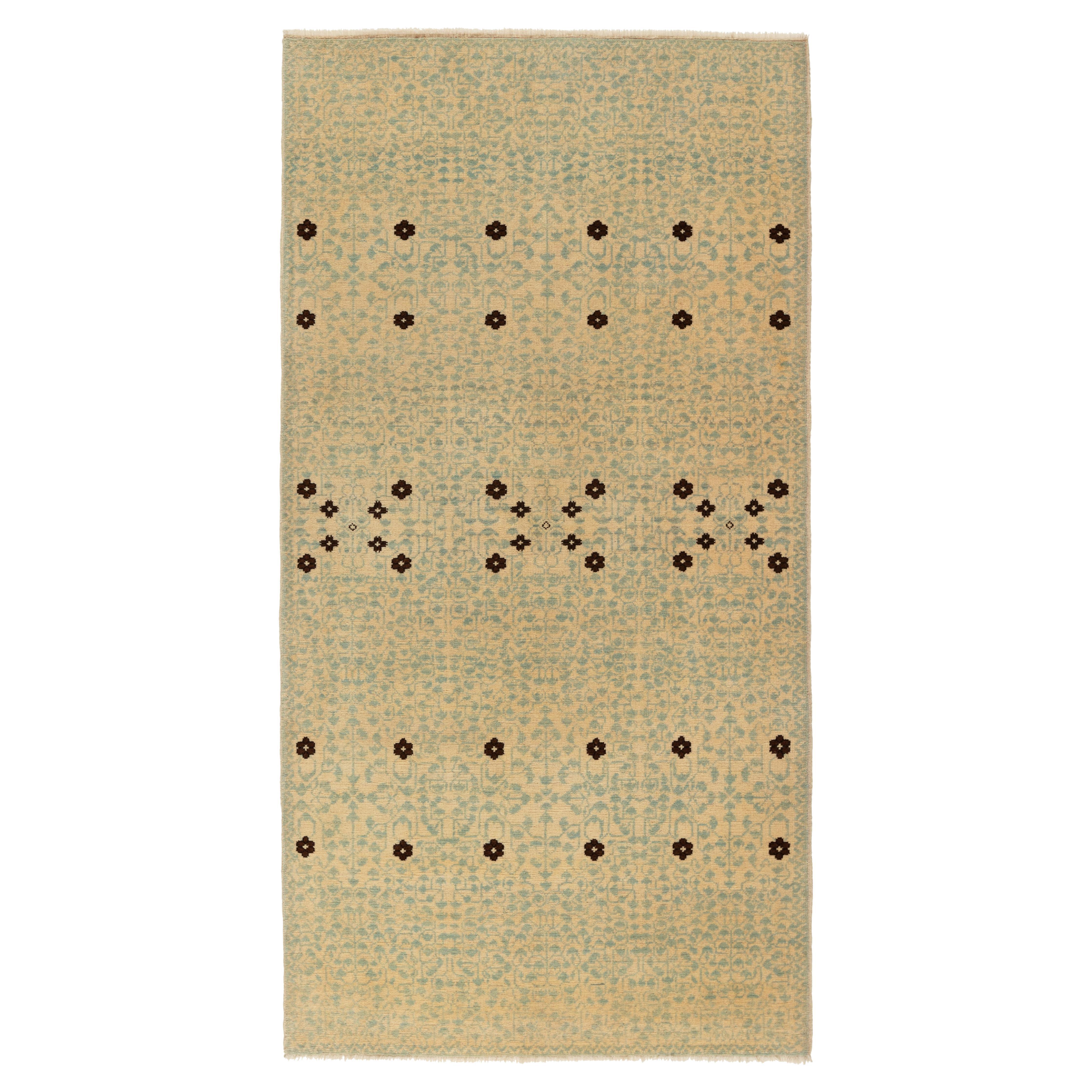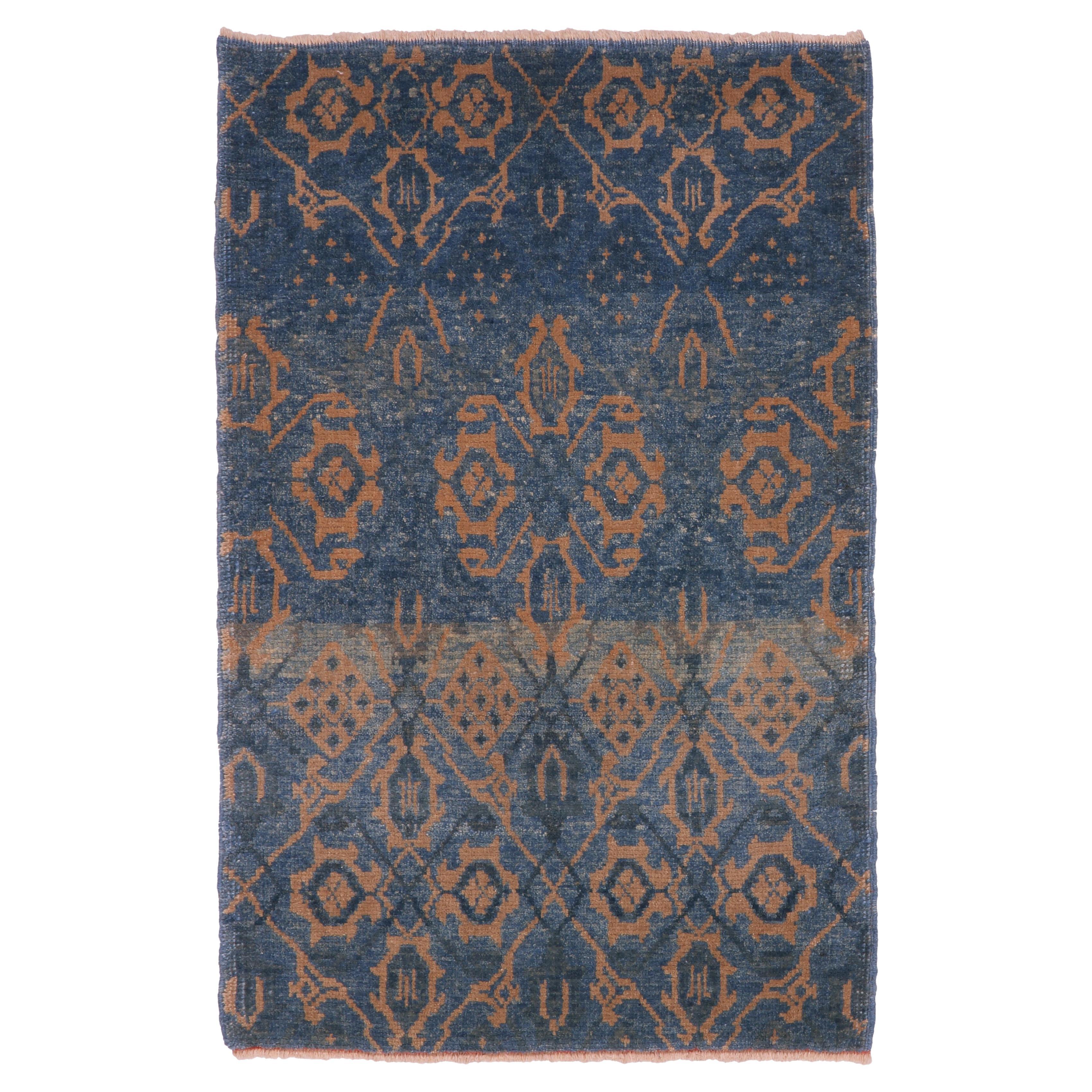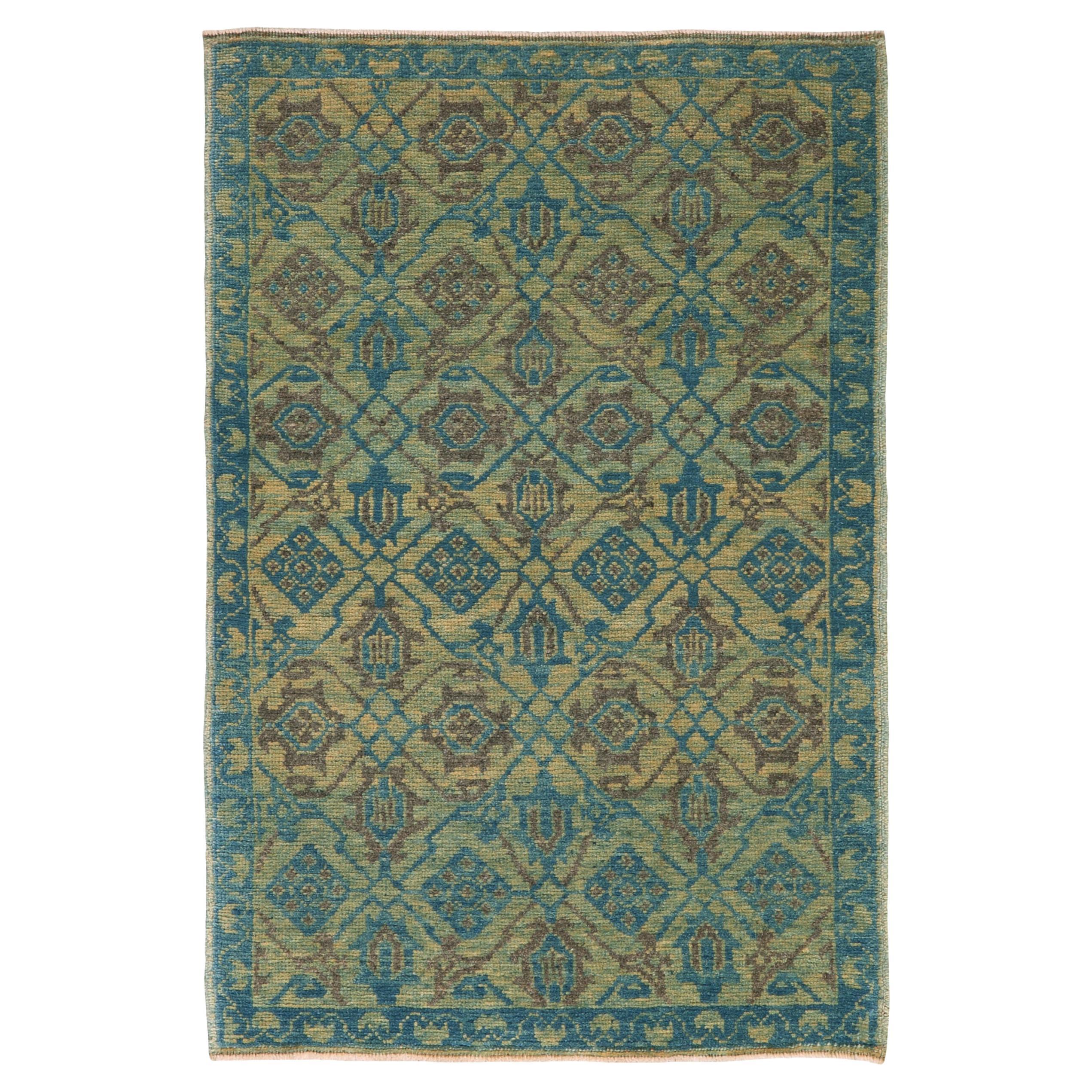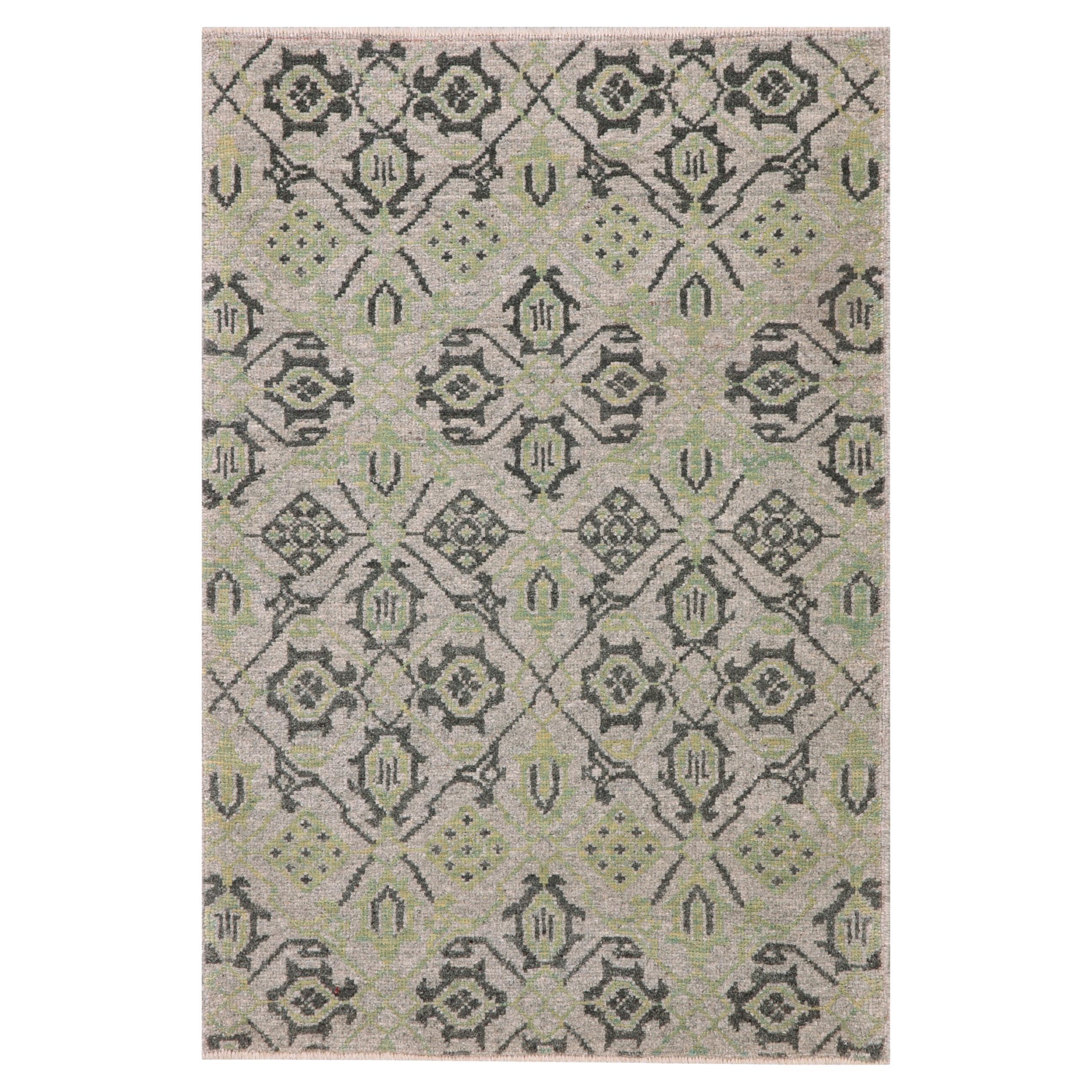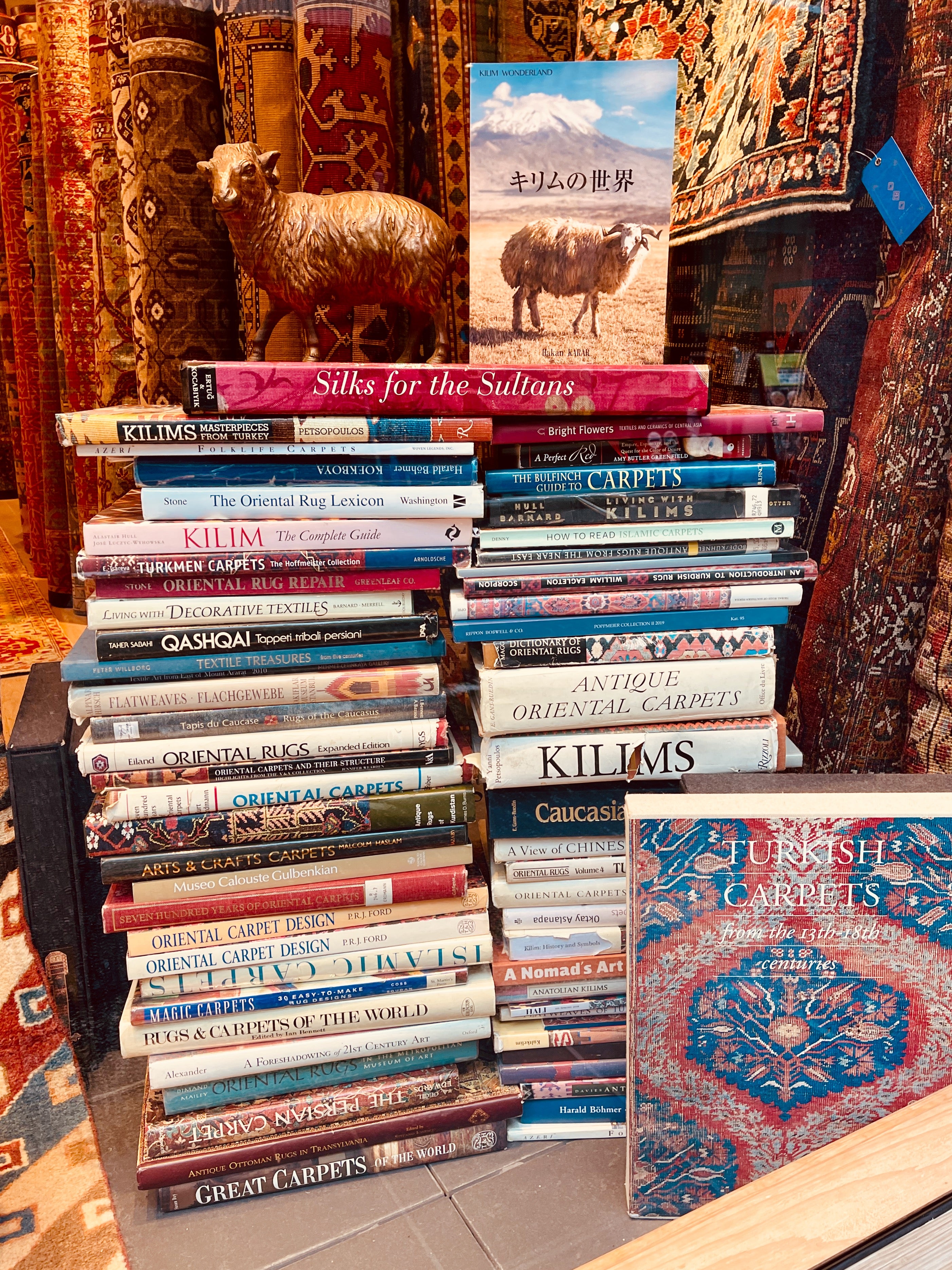Items Similar to Ararat Rugs Mamluk Carpet with Lattice Design, Antique Revival Rug Natural Dyed
Want more images or videos?
Request additional images or videos from the seller
1 of 5
Ararat Rugs Mamluk Carpet with Lattice Design, Antique Revival Rug Natural Dyed
About the Item
The source of carpet comes from the Mercer Collection Sotheby’s 2000 (catalog cover). This Mamluk-Cairene carpet is known, curiously featuring some type of lattice was designed in the early 16th-century rug by Mamluk Sultane of Cairo, Egypt. This piece from the Bavarian National Museum in Munich is the most interesting, and well qualified for a court appearance with its deployment of the Persian split-leaf arabesque placed daringly at the corners of the lattice. It has a sprightly, rhythmic elegance lacking in the other examples, such as the carpets in Berlin, Textile Museum, and the Mercer piece sold at Sotheby’s in 2000. Perhaps the starting point for this design venture was an Iranian model now lost to us. Only a similar type of Textile Museum carpet features the tulip-and-pineapple border usually reserved for medallion carpets, and the lattice design forms the accompanying background, incongruously, for a standard Mamluk medallion.
Attempting to read early carpets produced in workshops in Cairo provides an entirely different set of challenges. Cairene carpets, distinguished by their limited color palette, symmetrical knotting, and unusual construction of S-spun wool (Z-spun wool being the norm almost everywhere in the Islamic world), underwent a sudden change in design sometime after the Ottoman Turks conquered the Mamluk empire in 1517. The Simonetti Carpet was probably woven after the conquest but exhibits the “old” fifteenth-century style of the Mamluks. Long and narrow, it was woven on a standard-sized Egyptian roller-beam loom, capable of producing carpets of varying lengths. It consists of five major focal areas of design in an A-B-C-B-A pattern, meaning the first and fifth and the second and fourth areas are paired, while the middle is unique. We can easily term these five focal areas medallions, but they are geometric in both layout and detail, and their style (as opposed to the actual date of the weaving) predates the carpet design revolution that gave rise to the medallion format. We can surmise that the designs and colors of Mamluk carpets, with their unusual combination of insect-derived red, blue, green, and sometimes yellow, with virtually no undyed white at all, constitute an effort to create a recognizable brand in the early modern market, especially in Europe, where Mamluk carpets such as this, with their subtle coloration, incredibly detailed design, and mosaic-like layout of small and intricately patterned geometric motifs, constituted an appealing alternative to the more coarsely woven and brightly colored carpets from Anatolia, such as Ushak medallion carpets. While the weaving of carpets in the traditional geometric Mamluk designs apparently continued well into the seventeenth century, sometime around the mid-sixteenth century, Cairene weavers began to create an entirely new kind of carpet, using their traditional Mamluk materials, technique, and coloration but reflecting the latest styles then being created at the court of the Ottoman sultans in Istanbul. The design of the rug is interpreted by our designers, and soft colors are used for this rug.
Color summary: 6 colors in total, most used 4 colors are;
Turquoise 330 (Spurge – Madder Root – Indigo – Walnut Husk)
Natural Wool Color 37 (Specially Washed)
Pale Green 439 (Chamomile – Indigo)
Sunray Color 405 (Henna)
Group: Islamic Rugs Family
Area: Mamluk
Material of Pile: Natural Dyed Hand-spun Wool
Material Warp / Weft: Wool on Wool
Structure: Symmetrical knot on depressed warp inclining to the right
Knots Density: 39x39
Production Place: Southeastern Anatolia – Adiyaman Province
Stock Location: Tokyo
Size (EU): 126 X 241cm
Size (US): 4'1" X 7'10"
Area (EU): 3m²
Area (US): 32.7ft².
- Creator:Ararat Rugs (Manufacturer)
- Dimensions:Width: 49.61 in (126 cm)Length: 94.89 in (241 cm)
- Style:Revival (In the Style Of)
- Materials and Techniques:
- Place of Origin:
- Period:
- Date of Manufacture:2022
- Production Type:New & Custom(One of a Kind)
- Estimated Production Time:Available Now
- Condition:
- Seller Location:Tokyo, JP
- Reference Number:1stDibs: LU8206233206552
ARARAT RUGS
We know and believe that the geography we come from, our past, and our lifestyle are the most important bond between us to carry the oriental carpet art and culture to the next generations along with our core values in our ongoing growth journey.
We are aware that the way to achieve this goal and carry this priceless art and culture to the future depends on a lot of work with all our people every day while adhering to our core values.
For us, art is meaningful in the sense that it brings together various cultures around the world. It is an honor for us that oriental carpet art and culture have been instrumental in this for centuries and that we are a part of this business.
We are tirelessly keeping an eye on auction house information around the world about carpets. New York's Metropolitan, London's Victoria & Albert Museums, and other famous art museums, as well as small specialized museums that house private collections, and books about oriental carpets to collect information on outstanding carpet designs and patterns from around the world. It's our Self-improving and Self-developing culture.
As Turkish Culture of Hospitality, the Kurdish Culture of Generosity, and as Japanese Culture of Business Punctuality; are the most important values that this multicultural background has taught and bequeathed to us. It is essential and valuable for us that you feel this feeling not only by looking at our oriental carpets but from the moment you contact us.
About the Seller
5.0
Gold Seller
These expertly vetted sellers are highly rated and consistently exceed customer expectations.
Established in 1970
1stDibs seller since 2023
12 sales on 1stDibs
Typical response time: 1 hour
- ShippingRetrieving quote...Ships From: Tokyo, Japan
- Return PolicyA return for this item may be initiated within 7 days of delivery.
More From This SellerView All
- Ararat Rugs Mamluk Wagireh Rug Leaf Lattice Design, Revival Carpet Natural DyedBy Ararat RugsLocated in Tokyo, JPThe source of carpet comes from the book Völker, Angela, Die orientalischen Knüpfteppiche das MAK, Vienna: Böhlau, 2001: 42–5. That rug with the central star was designed in the early 16th Century rug by Mamluk Sultane of Cairo, Egypt. It is exhibited at MAK – Museum of Applied Arts, Vienna Austria. The interpreted design is composed of a leaf lattice pattern taken from the border of the MAK Museum’s rug...Category
21st Century and Contemporary Turkish Revival Turkish Rugs
MaterialsWool, Natural Fiber, Organic Material
- Ararat Rugs Mamluk Wagireh Rug with Palmette Lattice Revival Carpet Natural DyedBy Ararat RugsLocated in Tokyo, JPThis rug has an interpreted design composed of a palmette lattice pattern taken from a part of the Mamluk rug, filling the field elegantly. These kinds of rugs have often been descri...Category
2010s Turkish Revival Turkish Rugs
MaterialsWool, Natural Fiber, Organic Material
- Ararat Rugs Mamluk Wagireh Rug with Palmette Lattice Revival Carpet Natural DyedBy Ararat RugsLocated in Tokyo, JPThis rug has an interpreted design composed of a palmette lattice pattern taken from a part of the Mamluk rug, filling the field elegantly. These kinds of rugs have often been descri...Category
21st Century and Contemporary Turkish Revival Turkish Rugs
MaterialsWool, Natural Fiber, Organic Material
- Ararat Rugs Mamluk Wagireh Rug Lattice Pattern Revival Carpet Natural DyedBy Ararat RugsLocated in Tokyo, JPThis lattice pattern is composed of palmettes and leaves filling the various compartments against the imposing ground. One has the impression that it is only part of a larger scheme ...Category
21st Century and Contemporary Turkish Revival Turkish Rugs
MaterialsWool, Natural Fiber, Organic Material
- Ararat Rugs Mamluk Wagireh Rug Lattice Pattern Revival Carpet Natural DyedBy Ararat RugsLocated in Tokyo, JPThis lattice pattern is composed of palmettes and leaves filling the various compartments against the imposing ground. One has the impression that it is only part of a larger scheme designed 15th century rug from the Mamluk era, Cairo region, Eygpt. These designs have often been described as wagirehs or samplers and were said to have been used as weaver`s aids, or for demonstration purposes, made as a template or pattern for the carpet design and production of larger rugs, they are generally small pieces of the Size of a scatter rug or mat. Mamluk carpets originated in a physical environment that lacked the combination of abundant marginal grazing land and a temperate climate with cool winters that were common to most carpet-weaving areas in the Islamic world. While related to a broader tradition of Turkish weaving centered in Anatolia, far to the north, the designs of these carpets include atypical elements, such as stylized papyrus plants, that are deeply rooted in Egyptian tradition. Their unusual composition and layout probably represent an attempt to develop a distinctive product that could in effect establish a “Mamluk brand” in the lucrative European export market. The uncharacteristic color scheme—devoid of the undyed white pile and employing a limited range of three or five hues in much the same value—also suggests a conscious attempt to create a particular stylistic identity. Also virtually unique in the world of Islamic carpets is the S-spun wool. It has been argued that the tradition of clockwise wool spinning originated in Egypt because of the earlier Egyptian tradition of spinning flax into linen thread. Details of the plant’s botanical structure make it impossible to spin flax fiber in the more common counterclockwise direction utilized throughout the Middle East for wool and cotton. Mamluk carpets with the color combinations seen in the Simonetti are now generally accepted as part of an earlier tradition that has many links to the weaving of Anatolia, Iran, and Syria. The “three-color” Mamluk carpets, well represented in the Metropolitan’s collection, represent a later development that continued well after the Ottoman conquest of Egypt in 1517. Many such carpets may have been produced well into the seventeenth century, and possibly even later. (Walter B. Denny in [Ekhtiar, Soucek, Canby, and Haidar 2011]). The design of the rug is interpreted by our designers from our Mamlouk-type rugs collection and soft colors are used for this rug. Color summary: 3 colors in total; Moss Green 27 (Spurge – Indigo) Feldgrau 340 (Spurge – Madder Root – Indigo – Walnut Husk) Mount Olive...Category
21st Century and Contemporary Turkish Revival Turkish Rugs
MaterialsWool, Natural Fiber, Organic Material
- Ararat Rugs Mamluk Wagireh Rug Lattice Pattern Revival Carpet Natural DyedBy Ararat RugsLocated in Tokyo, JPThis lattice pattern is composed of palmettes and leaves filling the various compartments against the imposing ground. One has the impression that it is only part of a larger scheme ...Category
21st Century and Contemporary Turkish Revival Turkish Rugs
MaterialsWool, Natural Fiber, Organic Material
You May Also Like
- Antique Oushak Carpet, Oriental Rug, Handmade Grey, Ivory, SaffronLocated in Port Washington, NYTurkish carpet from Oushak with a combination of soft colors having an all-over design. Finely woven, having the most superb wool found in the mountains of Anatolia. This is a fine example of a Antique Oushak. Please contact us for more information. Oushak 11...Category
Antique Late 19th Century Turkish Oushak Turkish Rugs
MaterialsWool
- Antique Oushak Carpet, Oriental Rug, Handmade Rug Saffron, Light Blue and CoralLocated in Port Washington, NYWest Anatolia is one of the largest weaving regions in Turkey. Since the 15th century, Turkish rugs have always been on top of the list for having fine oriental rugs. Oushak rugs su...Category
Antique Late 19th Century Turkish Oushak Turkish Rugs
MaterialsWool
- Antique Oushak Carpet, Handmade Oriental Rug, Pale Blue Green, Yellow, Coral RugLocated in Port Washington, NYWest Anatolia is one of the largest weaving regions in Turkey. Since the 15th century, Turkish rugs have always been on top of the list for having fine oriental rugs. Oushak rugs s...Category
Antique 1880s Turkish Oushak Turkish Rugs
MaterialsWool
- Antique Oushak Carpet, Oriental Rug, Handmade Rug Saffron, Light Blue and CoralLocated in Port Washington, NYTurkish carpet from Oushak with a combination of soft colors having an all-over design. Finely woven, having the most superb wool found in the mountains of Anatolia. This is a fine e...Category
Antique Late 19th Century Turkish Oushak Turkish Rugs
MaterialsWool
- Antique Oushak Carpet, Handmade Oriental Rug, Pale Blue Green, Yellow, Coral RugLocated in Port Washington, NYWest Anatolia is one of the largest weaving regions in Turkey. Since the 15th century, Turkish rugs have always been on top of the list for having fine oriental rugs. Oushak rugs su...Category
Antique Late 19th Century Turkish Oushak Turkish Rugs
MaterialsWool
- Antique Oushak Carpet, Oriental Rug, Handmade Rug Pale Shrimp, Soft Coral, CreamLocated in Port Washington, NYOushak rugs, also known as Ushak rugs, are woven in Western Turkey and have distinct designs, such as angular large-scale floral patterns. They usually evoke a calmness and peacefuln...Category
Antique Late 19th Century Turkish Oushak Turkish Rugs
MaterialsWool
Recently Viewed
View AllMore Ways To Browse
Hand Dyed Blue Carpets
Lattice Rug
Green White Rug
White And Green Rug
Lattice Design Rug
Pair Of Lattice
Early 21st Century Living Room Rugs
Natural Turquoise Antique
Turquoise Colored Furniture
Egyptian Revival Style Furniture
Antique Egyptian Revival
Islamic Old
Yellow Background Geometric Rug
Walnut Tulip
Pale Yellow Rug
Z Style
Antique Mid Century Ottoman
Antique Tokyo
